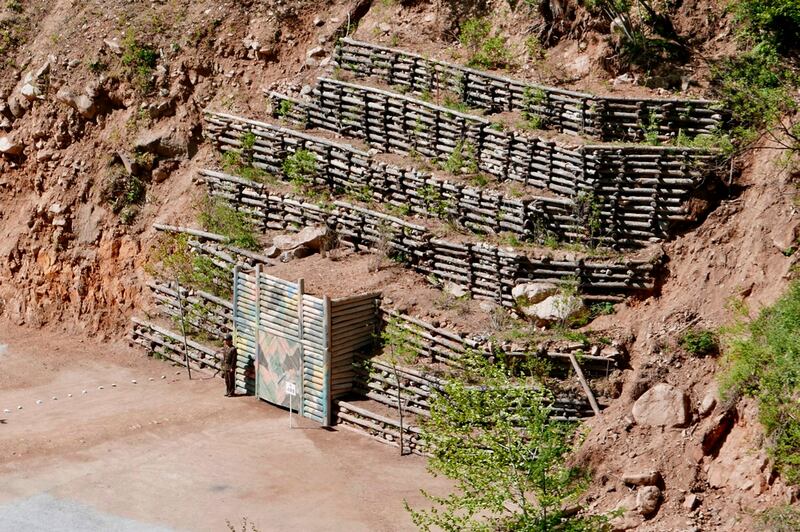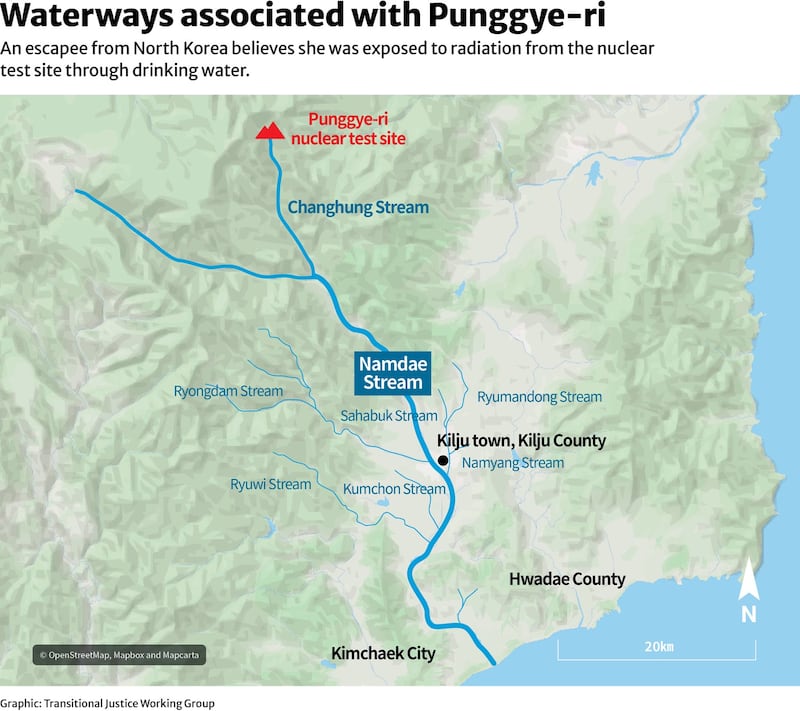Unexplained body aches. Mysterious illnesses. Puncturing a hole in your dying son’s side to drain fluid so he could breathe.
Such were the health issues that plagued two North Korean escapees who lived near the Punggye-ri site where Pyongyang conducted six underground nuclear tests between 2006 and 2017, and have since fled to South Korea.
One escapee who lived 27 kilometers (17 miles) from the test site in the northeastern part of the country said she lost her only child to a mysterious respiratory condition. Like other children in the area, he was diagnosed with tuberculosis, but now she believes it was a result of radiation.
It appeared like his lungs had melted, said the woman, asking to be identified by the pseudonym Lee Mi-young for security reasons.
“We pierced his side to drain the fluid three times a day. Pus came out and at the end he died,” said Lee. “He had eight friends, but one or two started to get sick and were diagnosed with tuberculosis. All of them died within four years. My son was diagnosed the same way.”
The North Korean doctors became frustrated when they could not determine how the children contracted tuberculosis, she said.
“The tuberculosis department doctor said that he didn't know why there were so many young people with tuberculosis in the hospital,” said Lee. “They didn't know that it was because of the nuclear experiment.”
It wasn’t until she arrived in South Korea in 2016 that Lee learned that the nuclear tests she once celebrated were almost certainly what killed her son and threatened her own life.
“When the third nuclear test was conducted [in 2013], people cheered excitedly after watching the broadcast,” she said. “I was proud that North Korea had developed nuclear weapons to ‘immobilize the Americans.’ I had no idea that it would have such a negative impact on the people.”
Radiation testing
In February, the South Korean Ministry of Unification announced that in May it would start testing 881 people who once lived near Punggye-ri before they escaped North Korea.
This year’s tests follow a first and second round of testing of about 40 people in 2017 and 2018.
Lee was among those tested in 2017, and her results showed a dosage of 270 millisieverts, far above the minimum level indicating radiation exposure. People are usually exposed to a natural radiation dose of 2-3 millisieverts per year.
The first and second rounds of testing detected exposure in nine of the tested subjects, one as dangerously high as 1,386 millisieverts.
Large doses of radiation can damage the body’s central nervous system and red and white blood cells, leaving the immune system unable to fight infections, but a spokesperson from the ministry told RFA that “no diseases related to radiation exposure were identified, and full-scale testing of North Korean escapees from the vicinity of the nuclear test site is underway as planned.”
Despite the lack of any identifiable disease, Lee said her head and body still ache, and she feels as if her bones “are soft.”
“People in North Korea didn’t know that the symptoms of the sickness are caused by radiation exposure,” she said. “They don’t know how bad nuclear radiation is for the human body.”

Back in North Korea, Lee said she could hardly worry about it because she was preoccupied with trying to make a living and simply survive.
She recalls now that at the time she lived near Punggye-ri, there were so many patients of severe disease living in Kilju county.
“Kilju County has the highest number of gastric, pancreatic, liver, tuberculosis, and lung cancer patients nationwide,” said Lee. “When cancer patients are diagnosed, they die within three months.”
When her son fell ill, she took him to Pyongyang hoping that the better doctors there could treat him. Travel to Pyongyang is all but illegal for ordinary citizens, and access to services reserved for North Korea’s elite is all but impossible.
“[We were] trying to go from the hospital [where he was being treated] to a hospital in Pyongyang. But the hospital told us that all tuberculosis and hepatitis patients in Kilju County cannot enter Pyongyang,” said Lee. “I couldn’t get the permit or certificate, so my son died without even the chance to be seen in the hospital in Pyongyang.”
Lee said that she felt sorry for the other residents of Kilju, who are like she was, unaware of the dangers of radiation exposure, with only the propaganda of North Korean authorities informing them that nuclear development will elevate the quality of their lives.
“All the citizens of Kilju county suffered [radiation] damage and they cannot come here [to the South],” she said. “All of them will die there like that. It is nonsense that nuclear development makes the citizens of Kilju county incredibly prosperous.”
She is convinced that the North Korean authorities must have already known that the tens of thousands of residents living near Punggye-ri are constantly exposed to radiation.
“Why wouldn’t they know?” she said. “The government knowingly neglects people…what kind of country is that?”
Tainted water
Another escapee, going by the pseudonym Kim Hwa-young, believes that she was exposed to radiation through drinking water before she escaped from North Korea in 2014. She had relied on water sources in Kilju county all her life, she said.
The streams in the area that fill the water reservoir for residents come from in Punggye-ri, she said. “All tap water comes from Punggye-ri.”
Satellite imagery of the area shows that at Namsok Reservoir a facility presumed to be an intake tower is noticeable on the southern side of the reservoir. It is therefore reasonable to presume that the Punggye-ri nuclear test site, situated on Mt. Mantap and located upstream, could be a source of drinking water and tap water for residents in and around Kilju county.
Lee, the first escapee, recalled changes in the water supply downstream from Punggye-ri – specifically the Namdae stream – after the nuclear tests began.
“Namdae stream was once clean and nice. Trout that lived in the stream were also good,” said Lee. “They were sent as a special product reserved for [former leader] Kim Il Sung, but at some point, no trout was seen in that stream, and pine mushrooms stopped growing there too.”
A compromised water source is a likely avenue for exposure and illness for many people who use it, Suh Kune Yull, a nuclear engineering professor at Seoul National University, told RFA.
“If these North Korean escapees were exposed to radiation, it can be predicted that the main route was the water source itself and agricultural products and livestock grown there,” said Suh, “The specifics can be known only after careful epidemiological investigations.”

Kim, the second escapee, recalled some of the symptoms she suffered while living in Kilju county.
“The headaches were all so bad. Almost all the Kilju people who came here with me still have headaches,” she said. “They don’t get better even if I use all kinds of different medicines. There is no diagnosis even if I go to the hospital.”
Upon her first health checkup in South Korea, Kim was diagnosed with a low white blood cell count, just like the others who escaped with her.
“I was told that I had hepatitis C and a low white blood cell count,” she said.
But when she was living in North Korea she witnessed people dying of diseases far worse than hers, she said.
“There were several people I knew who died from leukopenia,” said Kim, referring to a condition that prevents the body’s immune system from fighting disease. “There were very many cancer patients, including some who also had tuberculosis at the same time.”
“My next-door neighbor, his gums bled, and he died. This poor 4-year-old kid’s body was bruised all over as if it was pinched. And later he was diagnosed with leukopenia and died. His gums wouldn’t stop bleeding despite all kinds of medicine.”
People from outside the county also suffered by going there, she said.
“A man went to Kilju county to serve his 10-year mandatory service,” said Kim. “He had only a few hairs left and his whole body was weak by the time he was almost 40 years old. In the end, he couldn’t even get married.”
Kim said she and the others thought their illnesses were the result of not having enough food to eat, a common experience for many North Koreans.
“At that time everyone thought it was because … the people were not eating well,” she said. “When I lived in North Korea and was sick then, I never thought it would be because of the nuclear test. I wasn’t aware of all the risks of radiation exposure. I had no idea. It is a serious problem.”
Kim received a third radiation exposure test in May of this year and is waiting for the results.
During a previous round of testing, dangerous doses as high as 1,386 millisieverts were detected in some of the others who escaped from North Korea with Kim. Among the nine people who exhibited signs of radiation exposure in the previous rounds of testing, eight had said they drank tap or well water.
Geology
Contaminated drinking water from Punggye-ri may have been a result of the frequent earthquakes around nearby Mt. Mantap after each nuclear test, the Stimson Center’s Olli Heinonen, a former deputy director general of the International Atomic Energy Agency, told RFA.
"If there are cracks, rain, water and melting water from snow gets to these cracks and then goes through this place where the explosions took place,” he said. “And then finally, sooner or later enters that river which is passing through … and then it's in the groundwater."
Lee Su-gon, a former professor of civil engineering at the University of Seoul, who is one of the leading experts in the field of Korean geology, also emphasized that leakage of radioactive materials or contamination of groundwater is geologically inevitable due to the granite characteristics of Mount Mantap, a key peak in the area.
“Mount Mantap was already broken a lot because there are a lot of vertical joints,” he said. “Due to the nuclear tests, more radioactivity is released into the air … and the groundwater has no choice but to be contaminated. This can’t be stopped.”
Professor Lee also said that nuclear testing at Punggye-ri also caused frequent landslides, putting more people at risk of exposure.
“These landslides caused by vibrations under the ground… terrible when it comes to radioactive contamination issues,” he said. “So, it is a predictable problem for residents who defected from the area to claim that they were exposed to radiation. North Korean authorities are busy developing nuclear weapons and don’t take that into account.”
Translated by Leejin. J. Chung and Claire Shinyoung Oh Lee. Written in English by Eugene Whong. Edited by Malcolm Foster.
